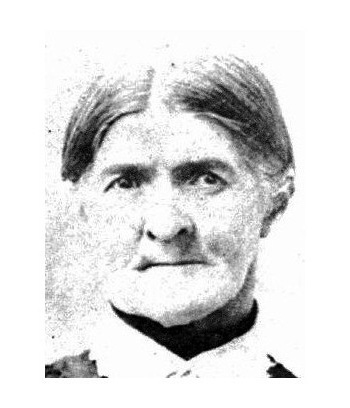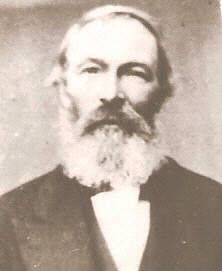Pioneer Conversion Stories Tell of Healing, Faith, Integrity
Contributed By Sarah Harris, Church News staff writer

President Heber C. Kimball of the First Presidency, second from right, is depicted in a portrait alongside other leaders of the early restored Church.
Article Highlights
- This is the third in a series of articles observing 170 years since the arrival of the first company of Mormon pioneers in the Salt Lake Valley in 1847.
“She was carried to the water, and after her baptism began to amend, and at her confirmation she was blest, and her disease rebuked, when she immediately recovered, and in less than one week after she was attending to her household duties. Thus was a miracle wrought that day.” —Heber C. Kimball
Related Links
Behind each Mormon pioneer’s narrative of faith and sacrifice is a unique story of conversion to the restored gospel of Jesus Christ.
Ann Elizabeth Hodgkinson Wamsley Palmer: “Given up to die by the doctors”
The conversion story of 1849 pioneer Ann Elizabeth Hodgkinson Wamsley (surname spelling varies in different accounts) Palmer—the first female convert to the Church in England—is one of miraculous healing.
In 1837, the Prophet Joseph Smith assigned Heber C. Kimball—a member of the Quorum of the Twelve Apostles later called as First Counselor in the First Presidency—to serve with the first LDS missionaries in England.

Ann Elizabeth Hodgkinson Wamsley Palmer was miraculously healed from an illness she had battled for several years after she was baptized as the first female convert to the Church in England. Photo courtesy of FamilySearch.org.

While then-Elder Heber C. Kimball of the Quorum of the Twelve Apostles was preaching the gospel with the first LDS missionaries in England, he taught Ann Elizabeth Hodgkinson Wamsley and promised her she would be restored to health and strength if she believed, repented, and was baptized. Photo courtesy of FamilySearch.org.
Soon after their arrival, the group traveled to Preston, where then-Elder Kimball visited the Wamsleys in their home. As recorded in Orson F. Whitney’s Life of Heber C. Kimball, Ann Elizabeth had been ill for several years when they met.
“She was reduced to skin and bones, a mere skeleton; and was given up to die by the doctors,” President Kimball wrote.
He promised her that she would be healed if she would believe, repent, and be baptized. Ann Elizabeth was baptized with the first group of converts in England on July 30, 1837, in the River Ribble near Preston.
“She was carried to the water, and after her baptism began to amend, and at her confirmation she was blest, and her disease rebuked, when she immediately recovered, and in less than one week after she was attending to her household duties,” President Kimball recalled. “Thus was a miracle wrought that day.”
William Wines Phelps: “I am going to join that church”

William Wines Phelps—author of several LDS hymns—first gained a testimony of the restored gospel through reading the Book of Mormon. Photo courtesy of FamilySearch.org.
The key to conversion for 1848 pioneer William Wines Phelps (known throughout his life as “W. W.”)—who later wrote the words to several LDS hymns including “If You Could Hie to Kolob”—was the Book of Mormon, according to the Doctrine and Covenants and Church History Student Study Guide.
This guide states that Phelps bought a copy of the Book of Mormon in 1830 and stayed up all night with his wife, Polly, reading and comparing it with the Bible.
“I am going to join that church; I am convinced that it is true,” William declared after finishing the Book of Mormon, according to the study guide.
Later that year, William visited Joseph Smith in Fayette, New York, and then moved with the Saints to Kirtland, Ohio. He and Polly were baptized on June 10, 1831—about a year after he had purchased his copy of the Book of Mormon.
“By that book began to unfold the mysteries of God, and I was made glad,” William stated in a letter to Oliver Cowdery.
Thomas John: “Forsake all if necessary”

Thomas John, a Welsh shoemaker, sacrificed friends and business for his decision to join the Church in 1851. Photo courtesy of FamilySearch.org.

Thomas John is pictured next to his wife, Margaret. The John family traveled across the plains with the Henry W. Miller company in 1862. Photo courtesy of FamilySearch.org.
1862 pioneer Thomas John’s conversion story, as told in a history written by his son Henry John, evidences Thomas’s integrity in sacrificing for what he knew was right.
Thomas was a Welsh shoemaker and a very religious man, according to the account. When the LDS missionaries came to Wales, they preached the restored gospel to the John family.
“Thomas immediately knew it was true,” Henry wrote. “So he studied, he prayed and inquired about it.”
But it was difficult for Thomas to separate from his friends in the Independent Church to which he had previously belonged and affiliate himself with a people “so very unpopular” as the Latter-day Saints, Henry related. This caused him “a lot of sleepless nights,” and he prayed to know whether to follow “the ways of men or the commandments of God.”
“He finally decided that he would forsake all if necessary and take up his cross and follow the Savior,” Henry wrote. “For why should he receive eternal life in the kingdom of God more than the Savior and his former disciples without suffering persecutions?”
Thomas was confirmed a member of the Church in May 1851. Prior to his baptism, Thomas had more work than he could keep up with in his business as a shoemaker, Henry recalled.
“But when the people learned that he had joined the church, they left him,” Henry recorded. “He had to seek work wherever he could find it and any kind of work he could find. The children were even mistreated on the school ground. The weight and oppression became so heavy that it seemed that he would have to despair.”
One day in the midst of these trials, Thomas prayed to know whether what he had done in joining the Church was right, and a feeling of light and “joy unspeakable” flowed over him.
“I have heard my father say when he became an old man, ‘I have never doubted since that day,’” Henry recalled.
• This is the third in a series of articles observing 170 years since the arrival of the first company of Mormon Pioneers in the Salt Lake Valley in 1847.
